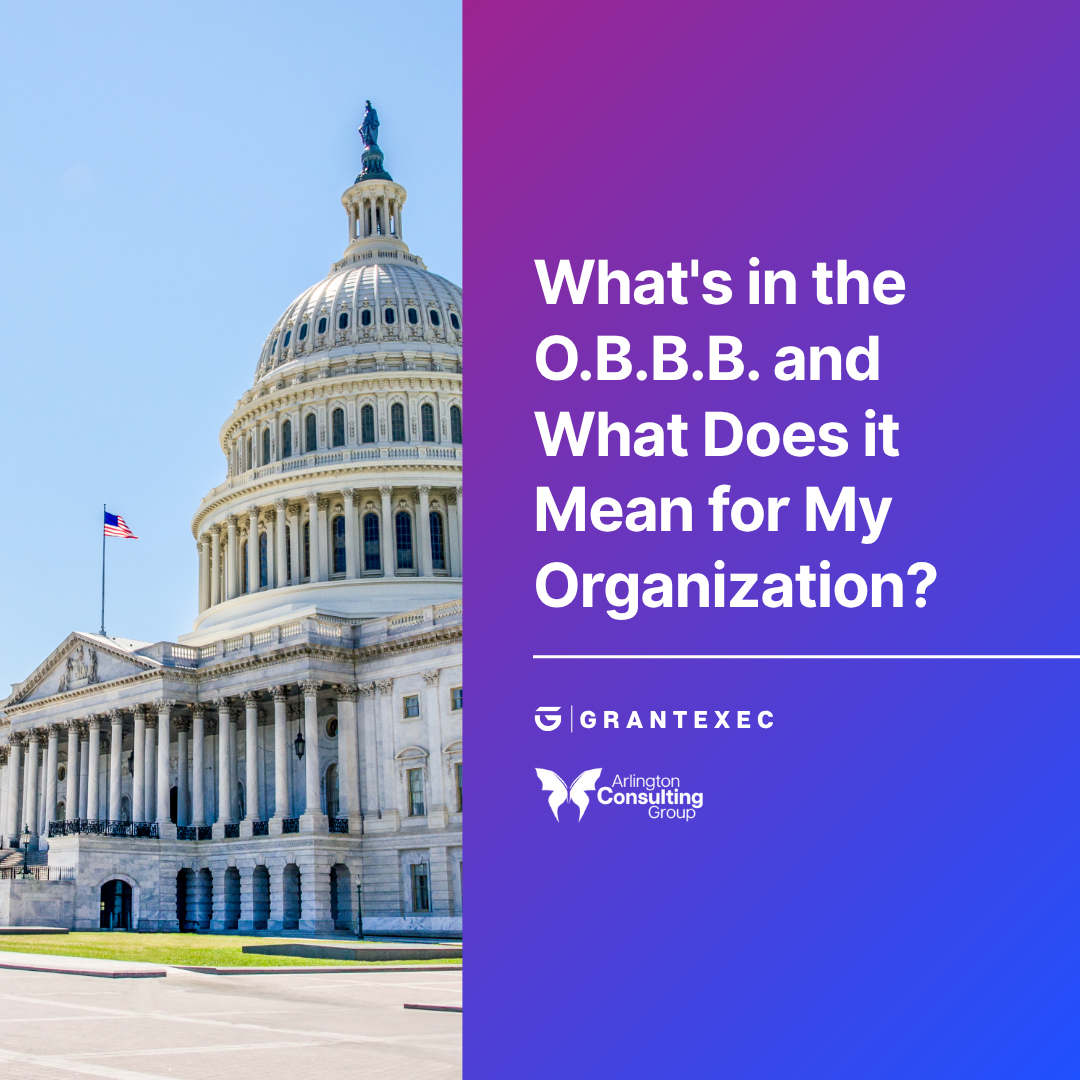
Webinar Recap: Understanding the Impacts and Opportunities of the "One Big Beautiful Bill"
GrantExec and Arlington Consulting Group Dissect Federal Spending Overhaul
This morning, GrantExec and Arlington Consulting Group presented an in-depth analysis of the Trump Administration's "One Big Beautiful Bill" (OBBB). Jared Cox, ex-McKinsey and Co-Founder and President of ACG, led the broad overview while Ryan Alcorn, Co-Founder and CEO of GrantExec, focused on the impacts for grantseekers.
The 870-page reconciliation package, signed into law on July 4th, represents what Cox called "President Trump's signature domestic legislative achievement." The bill extends $3.8 trillion in expiring Trump-era tax cuts while restructuring federal spending priorities.
Key Takeaways
Cox outlined the bill's central components: $379 billion in new defense and civilian spending, $1.3 trillion in social program cuts over the next decade, and rollbacks of $540 billion in clean energy subsidies. The legislation passed without a single Democratic vote, using budget reconciliation to avoid the filibuster.
"The breadth and scale cannot be overstated," Cox said. "It's going to touch every American household, industry and state government."
Defense and homeland security emerged as clear winners. DHS received $195 billion in additional funding, with $46 billion earmarked for border wall construction—triple the spending during Trump's first term. The Defense Department gained $153 billion above annual appropriations, potentially pushing its FY26 budget toward $1 trillion.
Grant Market Impact
Alcorn presented sobering data on the federal grant landscape. GrantExec's analysis identified $30 billion in rescinded grant funds, primarily affecting climate and environmental justice programs. Federal grant postings have dropped by nearly 30%, with over 15,000 existing awards worth $112 billion canceled.
"The federal grant making has already contracted significantly," Alcorn noted, attributing much of the reduction to the Department of Government Efficiency's review of existing awards.
Despite the cuts, new opportunities are emerging. A $50 billion Rural Health Transformation Program aims to offset some Medicaid reductions, though Alcorn cautioned it's "a drop in the bucket" compared to the $1 trillion in Medicaid cuts. Defense, border security, and agricultural conservation programs saw increases.
Strategic Guidance
Both presenters emphasized the need for organizations to adapt their approaches. Alcorn advised climate-focused organizations to reframe projects around administration priorities like water security or traditional conservation. "Language will be important for working with this administration, if you choose to do so," he said.
For federal contractors, Cox highlighted opportunities in defense modernization and border infrastructure, noting agencies face pressure to obligate funds quickly. He anticipates heavy use of GSA's OASIS+ vehicle to expedite spending.
State-Level Challenges
The presenters detailed significant implementation challenges for states, particularly around new Medicaid work requirements and SNAP eligibility verification. Cox warned that states face "unprecedented administrative burdens" that could disqualify eligible working people unable to navigate complex paperwork requirements.
States must also prepare for increased SNAP cost-sharing beginning in 2028, with obligations tied to error rates. California alone spent $2.6 billion on SNAP administration in 2023, illustrating the potential financial burden.
Alternative Funding Sources
With federal opportunities shrinking, Alcorn highlighted the importance of diversifying funding sources. GrantExec's data shows over $20 billion available in non-federal grants from foundations and corporations. He noted the Gates Foundation has doubled its giving and plans to spend down its endowment by 2045.
"Building those relationships, identifying those like-minded funders is critical," Alcorn said, while acknowledging private funding won't fully replace federal cuts.
Looking Forward
The presenters outlined expected timelines for new programs. Rural Health Transformation state plans are due December 31, 2025, with defense opportunities likely spiking in September. Workforce Pell provider pilots won't launch until mid-2026 due to required rulemaking processes.
Cox concluded with a warning about long-term fiscal implications. The bill adds $3.4 trillion to deficits over the next decade, with Social Security and Medicare trust funds facing depletion by 2032. "It's not here today but it's coming in the next few years," he said, predicting future pressure on discretionary spending.
Organizations seeking to navigate these changes can access GrantExec's expanded grant database and AI-powered matching tools at www.grantexec.com/dashboard, which tracks over $200 billion in active grant opportunities across federal, state, local, and private sources. For federal contractors and agencies looking to identify high-impact opportunities aligned with the new spending priorities, Arlington Consulting Group's Samwise market intelligence platform provides AI-driven analysis and strategic guidance for navigating the shifting federal landscape.

